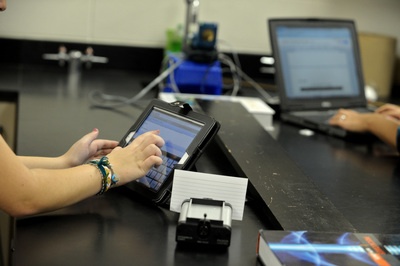Just a quarter of eighth and 12th grade students in the United States have solid writing skills, even when allowed to use spell-check and other computer word processing tools, according to results of a national exam released Friday.
Twenty-four percent of students at each grade level were able to write essays that were well developed, organized and had proper language and grammar. Three percent scored as advanced. The remainder showed just partial mastery of these skills.
"It is important to remember this is first draft writing," said Cornelia Orr, executive director of the National Assessment Governing Board, which administers the Nation's Report Card tests. "They did have some time to edit, but it wasn't extensive editing."
Students who took the writing test in 2011 had an advantage that previous test takers did not: a computer with spell-check and thesaurus. Previously, students taking the National Assessment of Educational Progress writing test had to use pencil and paper, but with changes in technology, and the need to write across electronic formats, the decision was made to switch to computers.
Orr said students use technology and tools like spell-check on a daily basis. "It's as if years ago we had given them a pencil to write the essay and took away the eraser," she said.

AP File Photo
She said word processing tools alone wouldn't result in significantly better writing scores if students didn't have the core skills of being able to organize ideas and present them in a clear and grammatical fashion.
Still, students in both grades who used the thesaurus and the backspace key more frequently had higher scores than those who used them less often. Students in the 12th grade who had to write four or five pages a week for English homework also had higher scores.
Because this was the first version of the computerized test, the board cautioned against comparing the results to previous exams. In 2007, 33 percent of eighth grade students scored at the proficient level, which represents solid writing skills, as did 24 percent at grade 12.
The results at both grade levels showed a continued achievement gap between white, black, Hispanic and Asian students. At the eighth grade, Asian students had the highest average score, which was 33 points higher than black students on a 300-point scale. At the 12th grade, white students scored 27 points above black students.
There was also a gender gap, with girls scoring 20 points higher on average than boys in the eighth grade and 14 points higher in 12th grade. Those who qualified for free and reduced price lunch, a key indicator of poverty, also had lower scores than those who did not; there was a 27 point difference between the two at the eighth grade.
For the 2011 exam, laptops were brought into public and private schools across the country and more than 50,000 students were tested to get a nationally representative sample. Students were given prompts that required them to write essays that explained, persuaded or conveyed an experience.
Kathleen Blake Yancey, a professor at Florida State University who served on the advisory panel for the test, said one factor to keep in mind is that research shows most students in the United States don't compose at the keyboard.
"What they do is sort of type already written documents into the machine, much as we used to do with typewriters four decades ago," she said.
Yancey said for this reason, there was some concern about having students write on the computer as opposed to by hand. Likewise, having the advantage of spell-check assumes students know how to use it. And in some schools and neighborhoods, computers are still not easily accessible.
"There are not so many students that actually learn to write composing at the keyboard," she said.
Yancey added that many kids who do have access to computers are not necessarily using them to write at school, but to take standardized tests and filling in bubbles.
"Digital technology is a technology," she said. "Paper and pencil is a technology. If technology were the answer, that would be pretty simple."